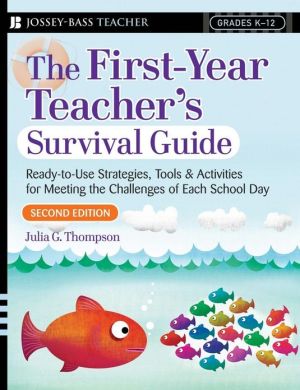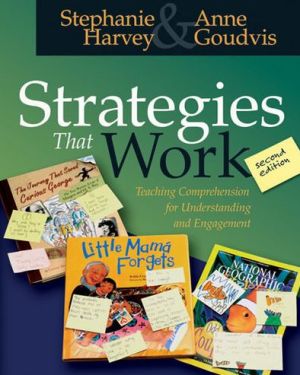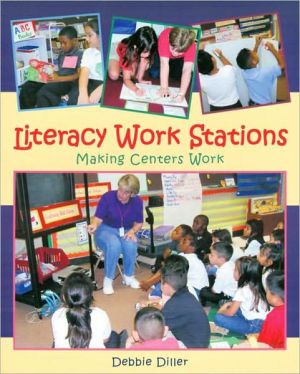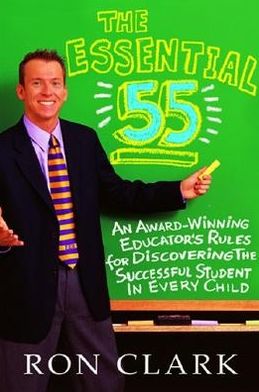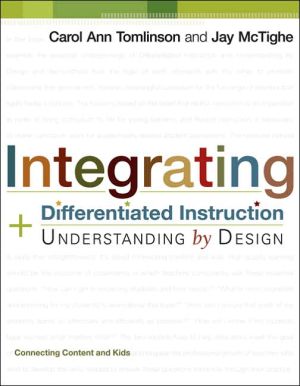The First Year Teacher's Survival Guide: Ready-to-Use Strategies, Tools and Activities for Meeting the Challenges of Each School Day (Jossey-Bass Teacher Series)
The best-selling First Year Teacher's Survival Kit gives new teachers a wide variety of tested strategies, activities, and tools for creating a positive and dynamic learning environment while meeting the challenges of each school day. Packed with valuable tips, the book helps new teachers with everything from becoming effective team players and connecting with students to handling behavior problems and working within diverse classrooms.\ The new edition is fully revised and updated to...
Search in google:
The best-selling First Year Teacher's Survival Kit gives new teachers a wide variety of tested strategies, activities, and tools for creating a positive and dynamic learning environment while meeting the challenges of each school day. Packed with valuable tips, the book helps new teachers with everything from becoming effective team players and connecting with students to handling behavior problems and working within diverse classrooms.The new edition is fully revised and updated to cover changes in the K-12 classroom over the past five years. Updates to the second edition include:• New ways teachers can meet the professional development requirements of the No Child Left Behind Act • Entirely new section on helping struggling readers, to address the declining literacy rate among today’s students • Expanded coverage of helpful technology solutions for the classroom • Expanded information on teaching English Language Learners • Greater coverage of the issues/challenges facing elementary teachers • More emphasis on how to reach and teach students of poverty • Updated study techniques that have proven successful with at-risk students • Tips on working effectively within a non-traditional school year schedule • The latest strategies for using graphic organizers • More emphasis on setting goals to help students to succeed • More information on intervening with students who are capable but choose not to work • Updated information onteachers’ rights and responsibilities regarding discipline issues • Fully revised Resources appendix including the latest educational Web sites and software
About the Author. Acknowledgments. About This Survival Guide. Section One: Get a Good Start in Your New Vocation. Your Teaching Career: The Good News. Core Values of Professional Educators. You Are Not Alone. You Are the Solution. How to Avoid Ruining Your Career. How to Be the Best Teacher You Can Be. How to Promote Your New Profession. Talk It Over: How to Get a Good Start in Your New Vocation. Section Two: Develop Your Professional Expertise. Advantages to Enjoy in Your First Years as a Teacher. Your Classroom Responsibilities. Look Ahead and Set Goals. How to Fulfill State and District Standards in Your Classroom. The No Child Left Behind Act and You. School Information, Policies, and Procedures You Need to Know. Professional Information, Policies, and Procedures You Need to Know. How to Share Space, Materials, and Equipment. Become an Efficient Teacher. Arrive a Little Early, Leave a Little Late. Manage Stacks of Paper with Ease. Your Teacher Binder. Find Your Mentors. Professional Organizations for Teachers. Journals to Help You Grow Professionally. Using the Internet as a Teaching Resource. Burnout Can Happen to You. The Safety Net of Professionalism. Talk It Over: How to Develop Your Professional Expertise. Section Three: Become a Valuable Team Player. Teamwork Skills That Build Success. What Your Co-Workers Expect from You. Diversity in the Workplace. How to Fit In. How to Maintain a Private Social Life. Mistakes No Teacher Should Make in Social Situations. The Support Staff.The Chain of Command. Working Well with Your Supervisors. The Evaluation Process. Working Well with Parents and Guardians. The Importance of Keeping Parent Contact Records. Open House. Take Care to Interact Professionally with Parents. Reach Out to Parents and Guardians. Conduct Successful Parent Conferences. How to Reach Out to Your Community. Talk It Over: How to Become a Valuable Team Player. Section Four: Organize Your Way to a Great Beginning. Lay Your Plans Before School Begins. Organize Your Time and Tasks. Establish Routines and Procedures. Organize Your Classroom. Connect with Your Students by Creating an Inviting Classroom. Two Special Classroom Situations. Set Up Your File Cabinet. Survey Your Classroom. Talk It Over: How to Organize Your Way to a Great Beginning. Section Five: Have a Fantastic First Day. Why the First Day Is Important. Overcome First-Day Jitters. Why You Need Seating Charts. What to Do on the First Day: Your Priorities. First-Day-of-School Welcome Packet. Activities for the First Day. Learn Your Students’ Names Quickly. How to Get to Know Your Students. Analyze Your Students’ Readiness for Success in Learning. Create a Positive Group Identity. Achieve Your First-Day-of-School Goals. Talk It Over: How to Have a Fantastic First Day. Section Six: Connect with Your Students. What Your Relationship with Your Students Should Be. Earn Your Students’ Respect. Mutual Respect, Mutual Courtesy. You Are a Role Model. "Are You Old Enough to Be a Teacher?". Handle Student Crushes with Care. How Much of Yourself Should You Share? Learn About Your Students. Promote Trust. How You Can Help Students Cope with Negative Peer Pressure. Teach Your Students to Believe in Themselves. How to Empower Students and Maintain Control of Your Class. Great Advice: Don’t Take It Personally. Cultivate Grace Under Pressure. Talk It Over: How to Connect with Your Students. Section Seven: Design Effective Lessons. The Benefits of Planning Every Lesson. How Prepared Should You Be? Begin with Your State’s Standards. How to Begin Planning Lessons. Capture the Big Picture with a Course Overview. Create Daily Plans That Work for You and Your Students. Common Planning Problems. Some Internet Lesson Plan Resources. How to Sequence Instruction. Tap Your Students’ Prior Knowledge. Perfect Your Pacing. Include Opportunities for Critical Thinking. Offer Your Students Options. How to Adjust a Lesson. Always Have a Backup Plan. Successful Learning When Your Class Is on a Nontraditional Schedule. Using Technology to Teach. Effective Lesson Plans When You Are Absent: What to Do When You Have to Miss School. Talk It Over: How to Design Effective Lessons. Section Eight: Deliver Effective Instruction. Let Your Enthusiasm Show. Guidelines for Improving Your Classroom Charisma. Avoid Pitfalls That Plague Too Many Teachers. Set the Stage. Use Body Language to Motivate Your Listeners. Pay Attention to Your Audience. Use Toys to Capture Attention. Make a Point That Students Will Remember. Help Students Stay on Track During a Lecture. Improve Your Oral Presentations. Meet the Needs of Students with Diverse Learning Styles. Activities That Accommodate Each Learning Style. Conduct Class Discussions That Engage Every Student. Strategies for Asking Engaging Questions. Use Essential Questions to Stimulate Critical Thinking. How to Publish Student Work. Use Graphic Organizers to Help Students Reach Mastery. Create Learning Centers for All Types of Students. Teach Your Students to Follow Directions. Make Seatwork Appealing. Practice: The Neglected Success Strategy. Using Class Time to Review. Talk It Over: How to Deliver Effective Instruction. Section Nine: Evaluate Your Students’ Progress. Prepare Your Class for Success on Standardized Tests. How to Design Effective Tests and Quizzes. Teach Your Students Successful Test-Taking Strategies. Rules of Student Conduct for Quizzes and Tests. Write Useful Comments on Student Papers. Tips on Grading Objective Questions. Grading Essay Questions Made Easy. How to Use Assessment Data. What to Do If Many of Your Students Fail a Test. How to Encourage Students to Correct Their Errors. Alternative Assessments. Keeping Track of Grades. How to Personalize a Grade Report. Talk It Over: How to Evaluate Your Students’ Progress. Section Ten: Motivate Your Students to Succeed. The Self-Fulfilling Prophecy. Ways to Motivate Your Students. Teach Your Students How to Set and Achieve Goals. "Why Do We Have to Learn This?". Design Lessons to Maximize Intrinsic Motivation. Add Interest to Assignments. Help Students Learn Through Working in Groups. Pair Students for Maximum Learning. Introduce Peer Tutoring for High Involvement. Use Games to Encourage Learning. Use Positive Reinforcement to Motivate Your Students. Talk It Over: How to Motivate Your Students to Succeed. Section Eleven: Help Your Students Become Successful Learners. Habits of Mind to Encourage. Incorporate Study Skills in Every Lesson. Teach Your Students How to Organize a Notebook. Teach Your Students to Think on Paper. Help Students Become Good Listeners. Teach Students to Speak in Front of the Class. Teach Students How to Memorize. Help Students Improve Their Writing Skills. Stop the Futile Cycle of Delayed Learning. Help Students Manage Their Stress. Help Students Meet Deadlines. Create a Homework Partnership. Develop a Homework Policy. Steps to Follow When Assigning Homework. Help Students Make Up Missed Work. CONTENTS xxi. Extra Credit Dilemmas and Solutions. Help Students Complete Long-Term Projects. Talk It Over: How to Help Your Students Become Successful Learners. Section Twelve: Make the Most of Your Instructional Time. You Control the Time Your Students Have with You. How Teachers Waste Time. Principles of Effective Classroom Time Management. Raising Your Students’ Awareness of Time. The First Ten Minutes of Class. Accommodating Students Who Work at Different Speeds. Productive Transitions. How to Handle Interruptions. How to Handle Requests to Leave the Classroom. The Last Ten Minutes of Class. Talk It Over: How to Make the Most of Your Instructional Time. Section Thirteen: Help Struggling Readers Find Success. Factors That Contribute to the Literacy Problem in Our Schools. Effective Reading Is Important for All Students. What Are the Most Important Reading Skills to Teach? Helping Students Comprehend What They Read. Enriching Students’ Vocabulary. Increasing Reading Fluency. Talk It Over: How to Help Struggling Readers Find Success. Section Fourteen: Manage Your Classroom Through Early Intervention. Why Punishment Is Not the Answer. Self-Discipline Is the Answer. Early Intervention Strategies. How to Set Up a Shared Supplies Bank. Create a Safe Environment for Your Students. Create Class Goals. Teach and Enforce School Rules. Create Classroom Rules. The Crucial Step: Monitoring. When You Should Act. Harness the Power of Positive Peer Pressure. Be a Consistent Teacher. Talk It Over: How to Manage Your Classroom Through Early Intervention. Section Fifteen: Handle Behavior Problems Effectively. Control Your Anxieties with Proactive Attitudes. Myths About Discipline. Behaviors You Should Not Accept. How to Avoid a Lawsuit: A Teacher’s Legal Responsibilities. You May Be the Troublemaker. Think Before You Act. Figure Out the Reasons for Student Misbehavior. Take a Problem-Solving Approach. Act Decisively. Don’t Give Up on Your Difficult Students. How to Deal with a Difficult Class. Hold Successful Student Conferences. Use Behavior Contracts Effectively. Put Detentions to Good Use. Manage Referrals to an Administrator with Confidence. Handling Common School Problems. Problem 1: Tardiness. Problem 2: Absenteeism. Problem 3: Overcrowded Classes. Problem 4: Substance Abuse. How to Intervene If You Notice Substance Abuse. Problem 5: Fighting. Problem 6: Harassment. Twenty-Five Discipline Don’ts. Talk It Over: How to Handle Behavior Problems Effectively. Section Sixteen: Manage Diversity in Your Classroom. Gifted Students........................................... 390. Special Needs Students...................................................................................... 394. Students with Attention Disorders. Students with 504 Plans. Students Who Are Underachievers. At-Risk Students. Students Living in Poverty. Ways to Help Disadvantaged Students. Students Who Are Not Native Speakers of English. Celebrate the Cultures in Your Class. Talk It Over: How to Manage a Diverse Classroom. Section Seventeen: Troubleshoot Twenty Common Problems. Problem 1: Heavy Backpacks Blocking the Aisles. Problem 2: Disruptive Cell Phones. Problem 3: Fire Drills. Problem 4: Drumming on Desks. Problem 5: Eating in Class. Problem 6: Note Passing. Problem 7: Public Displays of Affection. Problem 8: Dress Code Violations. Problem 9: Excessive Noise. Problem 10: Inappropriate Behavior at Assemblies. Problem 11: Restless Students During a Video Viewing. Problem 12: Lost Papers. Problem 13: Sleeping in Class. Problem 14: Crying. Problem 15: Feigned Illness. Problem 16: Inappropriate Comments. Problem 17: Talking Back. Problem 18: Defiance. Problem 19: Theft. Problem 20: Cheating by Copying from an Online Source. Talk It Over: How to Troubleshoot Problems. Index.
